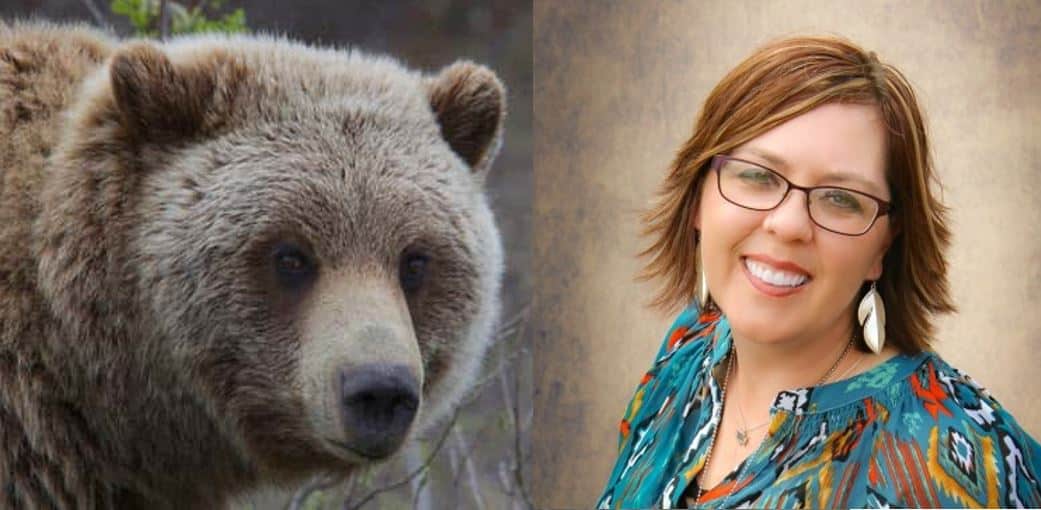By Trina Jo Bradley
BIRCH CREEK — One summer evening when my daughter was a toddler, I took her by the hand and walked into the backyard to water the garden, when our dog began to bark like mad.
I looked up and saw a grizzly bear on the other side of the garden. I had only a second to think, and since the dog had the bear occupied, I scooped up my daughter and dashed back in the house.
That’s what life is like when you live with grizzlies. My husband and I run Angus cattle and Quarter Horses on our family place on Birch Creek, along the Rocky Mountain Front in Pondera and Glacier counties. Our ranch is rolling foothills of grassland, irrigated alfalfa and a creek lined with cottonwood trees.
Visitors to Glacier National Park – located just 40 miles north of our ranch – get a thrill from a chance to see a grizzly bear. But for us, grizzlies are 24-7 neighbors. The stress of living with an apex predator affects us every day of the year.
Thankfully, there are proven tools available that help reduce livestock depredations and the other costly expenses that come with bears and other wildlife. The remaining question is, who should pay for them?
In an effort to keep losses at a minimum, we employ a few different conflict prevention practices. I’ve got an electric fence around my chicken coop in the yard to keep out bears, coyotes, and other predators. We’ve made changes to how and when we turn baby calves out in the spring, and we’ve had to adjust the summer pasture rotations in order to avoid grizzly bears, which means we can no longer utilize some of our best grazing.
Other conflict-prevention tools include range riders – hired hands who monitor cattle herds, looking for signs of trouble and increasing the human presence on remote pastures. Livestock Guarding Dogs and Karelian Bear Dogs can be very effective at deterring predators. Systems for effectively storing garbage and disposing of dead livestock carcasses are also a big help.
Predators are smart, so unfortunately none of these tools are 100 percent effective. Every producer’s situation is unique. Often, it takes several different conflict prevention tools deployed together to be successful. Having access to as many options as possible is key.
But these options cost money. Livestock producers work tirelessly to make sure their families and livestock are safe but are generally operating on very thin profit margins. Predators, like weather, can be one of those uncontrollable factors that can push a ranch into real economic trouble.
Our society has decided that we need predators like grizzly bears, wolves, and mountain lions on the landscape, but as it stands, ranchers and farmers are left to carry a hugely disproportionate share of the costs.
Those costs come in obvious ways – like a calf that never makes it to market because it was eaten by a grizzly bear. But there are other less obvious, but equally real, burdens as well. When nursing cows are stressed or have to be taken off their best pasture, their calves may fail to gain weight, and the conception rates for the herd suffer. Plus, there are the real costs of worry that comes with having apex predators living near your home.
Conflict prevention tools can help reduce those risks, but the financial burden needs to be spread more fairly. Right now, Montana livestock producers, management agencies and conservationists are trying to raise public funds to get more of these tools on the ground. Some funding is available, but there is always need for more. With the ever-growing populations of grizzly bears, wolves, and other large predators, the need for prevention is expanding across the state.
We need to urge Governor Gianforte, Rep. Rosendale, and Sens. Daines and Tester to establish predictable funding that ag producers can depend upon. We also need the rest of the world to step up and contribute to the management of the public’s wildlife, and the preservation of the western way of life.
There is no time to waste. Right now, the drought has taken a toll on the service berries and chokecherries our local bears normally rely on in the fall. Soon, bears will go into hyperphagia as they put on fat for winter, and the only things available for some of them to eat are crops and livestock. We need conflict prevention tools in place immediately.
Our ranch is our home, but it is also our livelihood. What many people fail to realize is that the wildlife is here because our ranch is protecting open space, and because our stewardship and conservation practices keep the land healthy. We are happy to share it with all kinds of wildlife, but it is time for the rest of society to contribute to the management of these predators.
Montana is big enough for family farms and ranches AND our abundant wildlife resources. What makes it work is when we plan ahead, work together, and put proven tools to work on the ground.
###
Trina Jo Bradley operates a family ranch with her husband and is executive director of the Rocky Mountain Front Ranchlands Group.


